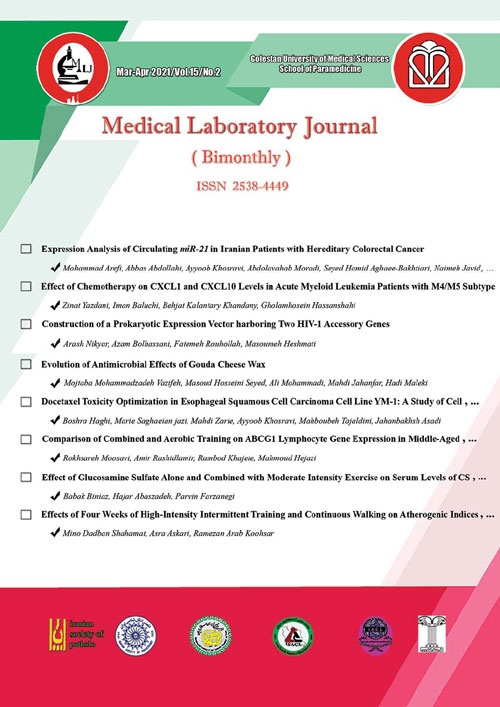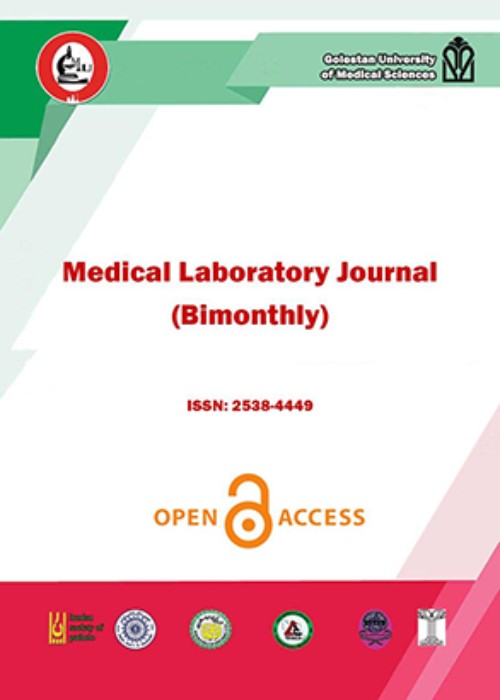فهرست مطالب

Medical Laboratory Journal
Volume:16 Issue: 2, Mar-Apr 2022
- تاریخ انتشار: 1401/01/25
- تعداد عناوین: 8
-
-
Pages 1-6
The current study aimed to introduce key ethical issues related to laboratory-based diagnostics that any individual may encounter during the provision of healthcare services. In a systematic review, relevant studies published on electronic databases including the PubMed, Scopus, Web of Science, Medline and Cochrane Library were collected for the years 1975 to 2020. The ethical issues related to clinical laboratories diagnosis and patients, colleagues, and society in different phases of laboratory testing were surveyed in this study. Considering ethical issues must be prioritized in each clinical laboratory for better dealing with clients, collaborators, and the community.
Keywords: Laboratories, Clinical, Ethics, Medical, Patient Rights, Confidentiality -
Pages 7-12Background and objectives
Polycystic ovary syndrome (PCOS) is one of the most common endocrine disorders that affect fertility. In this syndrome, the rate of fibrotic tissue formation and structures such as collagen increases. This study intended to evaluate protective effect of apigenin on ovarian follicles in PCOS-induced female Wistar rats.
MethodsIn this experimental study, 60 adult Wistar rats (weight: 200-250 g) were used. A vaginal test was performed to confirm induction of PCOS. Then, the rats were randomly divided into four groups: 1) control, 2) PCOS, 3) PCOS+apigenin (10 mg/kg), and 4) PCOS+apigenin (20 mg/kg). The rats in the experimental groups received apigenin solution via intrapertoneal injection for 14 days. Next, the ovarian tissue of animals was removed and subjected to histological studies. Data were analyzed using one-way ANOVA and Tukey's post hoc test. Statistical analysis of data was carried out in SPSS (version 20), and significance level was set to 0.05.
ResultsThe number of secondary cystic follicles in groups treated with apigenin (10 and 20 mg/kg) decreased significantly compared to the PCOS group (group2) (P≤0.05). Despite the reduction in the number of follicles, this reduction for the primary follicles was not statistically significant. Moreover, treatment with apigenin had no significant effect on the number of graph follicles (p≥0.05).
ConclusionOur findings indicate that apigenin might be useful in controlling PCOS. Therefore, it may be suggested as a supplement to improve fertility of patients with PCOS.
Keywords: Apigenin, Wistar Rats, Polycystic Ovary Syndrome, Ovarian Follicle -
Pages 13-20Background and objectives
The incidence of candiduria caused by Candida spp. has increased in recent years, particularly in hospitalized patients. Candiduria is most commonly caused by Candida albicans; however, an increase in the prevalence of non-albicans species has been observed during last decades. This study aimed at molecular identification of Candida species isolated from candiduria in hospitalized patients.
MethodsThis cross-sectional study was conducted on 530 hospitalized patients in two hospitals in the Mazandaran Province, Iran. Midstream urine specimens were collected and then cultured on CHROMagar Candida medium. Molecular identification of common Candida species was carried out using the polymerase chain reaction-restriction fragment length polymorphism method after enzymatic digestion with MspI. C. albicans and Candida parapsilosis species complexes were identified by amplification of the HWP1 and intein-containing vacuolar ATPase precursor genes, respectively.
ResultsThe frequency of candiduria was estimated at 14% among hospitalized patients. Of 74 samples positive for candiduria, 65 (87.8%) were isolated from females. The most common predisposing factor to candiduria was diabetes (n=36; 48.6%). The most frequent isolates were C. albicans complex (n=44; 59.4%), followed by Candida glabrata (n= 16; 21.6%), Candida tropicalis (n= 10; 13.5%), Candida Krusei (n= 3; 4%) and C. parapsilosis (n= 1; 1.3%).
ConclusionBased on the results, the conventional and molecular methods produced similar results for identification of Candida species. However, accurate identification of Candida spp. requires the use of molecular techniques such as PCR-RFLP, HWP1, and intein-containing vacuolar ATPase precursor genes. Nevertheless, chromogenic methods such as CHROMagar Candida can be used for diagnosis of Candida spp. in laboratories with limited resources.
Keywords: Candida, Urine, Polymerase Chain Reaction -
Pages 21-26Background and objectives
Recycled polyethylene terephthalate (RPET) nanofibers have become an important part of human life, with a continuous increase in their production and consumption. Herein, the antibacterial activity of nickel nanoparticles/recycled polyethylene terephthalate nanofibers (NiNP/RPET NF web) was evaluated by analyzing alginate expression in Pseudomonas aeruginosa, as an opportunistic microorganism.
MethodsNiNPs were synthesized and NiNP/RPET NF was produced by adding 25 μg/ml of NiNP to 10% solutions of RPET at a weight ratio of 3%. After exposing P. aeruginosa (PA01) to NiNP/RPET NF, the biofilm-forming capacity was determined and real-time PCR was performed to measure algD expression.
ResultsTreatment with 25 μg/ml of NiNP/RPET NF reduced growth of P. aeruginosa on Mueller Hinton agar but did not result in complete inhibition. The biofilm optical density (550 nm) was 0.464 ± 0.021 after treatment with NiNP/RPET NF and 0.082± 0.011 in the absence of NiNP/RPET NF. This indicates the significant reduction of biofilm formation after exposure to NiNP/RPET NF (p=0.01). In addition, a 0.6-fold (p=0.03) reduction in alginate expression was detected by real-time quantitative real-time PCR.
ConclusionOur results indicate the potential of NiNP/RPET NF for application in nano-based antibacterial medical systems.
Keywords: Nickel nanoparticles, polyethylene terephthalate, recycling, Pseudomonas aeruginosa, Alginate -
Pages 27-33Background and objectives
Previous investigations have shown that physical activity can improve insulin sensitivity and body composition by reducing the concentration of inflammatory biomarkers. The study aimed at evaluating effects of eight weeks of resistance training and high-intensity interval training on adropin, blood glucose markers, and body composition in overweight females.
Methodssixteen overweight females (mean age: 30 ± 4.3 years and body mass index= 29 ± 2.6 kg/m2) were randomly assigned to a resistance training group (n=8) and a high-intensity interval training group (n=8). Participants in both groups trained three times a week for eight weeks. Body composition and serum level of blood markers were determined at baseline and after the last training session.
ResultsBody mass, body fat percentage, and waist-hip ratio decreased significantly in both groups (p<0.05). VO2max significantly increased in both groups, while the changes in the resistance training group were greater than in the high-intensity interval training group (p<0.05). Insulin and HOMA-IR concentrations decreased significantly in the resistance training group (p<0.05).
ConclusionEight weeks of both training procedures could significantly decrease body composition markers. However, the training duration was not sufficient to alter fating blood sugar or adropin concentrations.
Keywords: Body composition, obesity, resistance training, high-intensity interval training -
Pages 34-40Background and objectives
Vascular senescence refers to specific aging-associated changes in the endothelial cells. The purpose of this study was to investigate effects of 12 weeks of resistance training with elastic bands on circulating endothelial cell-derived microRNA-92a and endothelin-1 (ET-1) in elderly women with osteosarcopenic obesity (OSO).
MethodsIn the present randomized clinical trial, 48 elderly women with OSO were randomly divided into a control group (n=22) and an experimental group (n=26). The subjects in the intervention group performed 12 weeks of resistance training with elastic bands three times a week. The participants became familiar with targeted number of repetitions and OMNI-resistance exercise scale to control exercise intensity.
ResultsThe mean age, body fat percentage, body mass index (BMI), and bone mineral density T-score for the hip and L1-L4 lumbar spine of the subjects were 64.13±3.68 years, 45.4%±6.56, 33.1±3.71 kg/m2, and -1.86±1.42, respectively. After the 12-week resistance training, we observed a significant decrease in serum level of mir-92a in the experimental group compared to the control group (p=0.03). However, there was no significant difference between the study groups in terms of body weight, BMI, body fat percentage, total cholesterol, and ET-1 (p≥0.05).
ConclusionThe 12-week resistance training program seems to modulate and decrease serum mir-92a expression in elderly women with OSO. The lack of a significant change in BMI, body fat percentage, and ET-1 levels following the exercise training might be due to the type and intensity of the exercises.
Keywords: Resistance Training, Obesity, Sarcopenia, Osteoporosis, Aged, Vascular Stiffness -
Pages 41-47Background and objectives
Hypertension is associated with vascular remodeling, which is supported by the protein disulfide isomerase A1 (PDIA1). Exercise training has beneficial effects on vascular function in subjects with hypertension. Alpha lipoic acid (ALA) is a powerful biological antioxidant. However, the role of exercise training and ALA on PDIA1 are not well understood. The aim of the present study was to investigate effects of training with different intensities and ALA supplementation on PDIA1 expression in cardiomyocytes of hypertensive rats.
MethodsIn this experimental study, 35 male Wistar rats (age: eight weeks, weight: 190-220 g) were randomly divided into seven groups: control, hypertensive, hypertensive+ALA, hypertensive+high intensity interval training (HIIT), hypertensive+moderate-intensity training (MIT), hypertensive+HIIT+ALA, and hypertensive+MIT+ALA. Hypertension was induced by three weeks of L-NAME administration (40 mg/kg/day). The HIIT and MIT protocols was performed five days a week for six weeks. The HIIT protocol consisted of 10 bouts of four minute-running at 80–85% of Vmax, and the MIT protocol consisted of 13 bouts of four minute-running at 55–60% of Vmax. In the supplementation groups, 20 mg/kg of ALA was administered orally once a day. Immunohistochemistry staining was used to study protein expression.
ResultsInduction of hypertension significantly decreased PDIA1 expression compared to the control group (p=0.001). Moreover, PDIA1 expression increased significantly in the hypertensive+ALA (p=0.023), HIIT (p=0.001), MIT (p=0.007), MIT+ hypertensive+ALA (p=0.0001) and HIIT+ hypertensive+ALA (p=0.0001) group compared to the control group.
ConclusionHypertension is associated with decreased cardiac PDIA1 level, and both HIIT and MIT along with ALA supplementation are effective in increasing cardiac PDIA1 expression in hypertension.
Keywords: Exercise, alpha-lipoic acid, hypertension -
Pages 48-55Background and objectives
Developing scaffolds is important for tissue engineering and repairing damaged tissues. The present study aimed to investigate effects of pre-incubation of an electrospun silk fibroin scaffold in complete and serum-free media on proliferation and survival of cells seeded on the scaffold.
MethodsAfter removing sericin from the silk cocoon and preparing the fibroin solution (3% w/v), the electrospun silk fibroin scaffold was fabricated and its morphology was evaluated by scanning electron microscopy. The scaffolds were pre-incubated in complete and serum-free Dulbecco's Modified Eagle media for one hour (short-term) and 10 days (long-term), and the hydrophilicity of scaffolds was evaluated by measuring the water contact angle. Rat bone marrow mesenchymal stem cells were seeded onto the scaffolds, and cell survival and genomic DNA concentration were evaluated after 21 days.
ResultsThe short-time pre-incubation of electrospun silk fibroin scaffolds in the complete medium increased the proliferation of seeded cells because of serum protein adsorption. In addition, long-term pre-incubation of the scaffolds in the complete and serum-free media increased cell proliferation due to the increased hydrophilicity of the scaffold (p<0.05). However, only long-term pre-incubation of the scaffolds in the complete medium had a significant effect on cell survival.
ConclusionThe results demonstrated that long-term pre-incubation of the scaffolds in the complete medium have more profound positive effects on cell survival and proliferation compared to short-term pre-incubation.
Keywords: Tissue Culture Techniques, Blood Proteins, Culture Media Serum-Free


